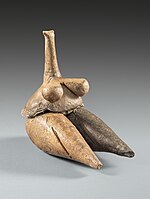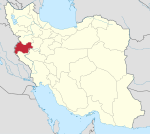| تپه گنج دره | |
  | |
| Location | Kermanshah Province, Iran |
|---|---|
| Region | Gamas-Ab Valley |
| Coordinates | 34°16′20″N 47°28′33″E / 34.2721°N 47.4758°E / 34.2721; 47.4758 |
| Altitude | 1,400 m (4,593 ft) |
| Type | mound settlement |
| History | |
| Founded | c. 8200 BC |
| Abandoned | c. 7600 BC |
| Periods | Neolithic |
| Associated with | early villagers/ agro-pastoralists |
| Site notes | |
| Excavation dates | 1965-1974 and 2017-2018. |


Ganj Dareh (Persian: تپه گنج دره; "Treasure Valley" in Persian, or "Treasure Valley Hill" if tepe/tappeh (hill) is appended to the name) is a Neolithic settlement in western Iran. It is located in the Harsin County in east of Kermanshah Province, in the central Zagros Mountains.
Research history
First discovered in 1965, it was excavated by Canadian archaeologist, Philip Smith during the 1960s and 1970s, for four field seasons. In 2017-18, the site was revisited by an Iranian-Danish team of archaeologists under direction of Hojjat Darabi and Tobias Richter. The oldest settlement remains on the site date back to ca. 10,200 years ago, and have yielded the earliest evidence for goat domestication in the world. The only evidence for domesticated crops found at the site so far is the presence of two-row barley.
The remains have been classified into five occupation levels, from A, at the top, to E.
Ceramics
Ganj Dareh is important in the study of Neolithic ceramics in Luristan and Kurdistan. This is a period beginning in the late 8th millennium, and continuing to the middle of the 6th millennium BC. Also, the evidence from two other excavated sites nearby is important, from Tepe Guran, and Tepe Sarab (shown on the map in this article). They are all located southwest of Harsin, on the Mahidasht plain, and in the Hulailan valley.
At Ganj Dareh, two early ceramic traditions are evident. One is based on the use of clay for figurines and small geometric pieces like cones and disks. These are dated ca. 7300-6900 BC.
The other ceramic tradition originated in the use of clay for mud-walled buildings (ca. 7300 BC). These traditions are also shared by Tepe Guran, and Tepe Sarab. Tepe Asiab is also located near Tepe Sarab, and may be the earliest of all these sites. Both sites appear to have been seasonally occupied. Another site from the same period is Chia Jani, also in Kermanshah. Chia Jani is located about 60 km southwest from Ganj Dareh.
Ali Kosh is also a related site of the Neolithic period.
Archaeogenetics
Researchers sequenced the genome from the petrous bone of a 30-50 year old woman from Ganj Dareh, GD13a. mtDNA analysis shows that she belonged to Haplogroup X. She is phenotypically similar to the Anatolian early farmers and Caucasus Hunter-Gatherers. Her DNA revealed that she had black hair, brown eyes and was lactose intolerant. The derived SLC45A2 variant associated with light skin was not observed in GD13a, but the derived SLC24A5 variant which is also associated with the same trait was observed.

GD13a is genetically closest to the ancient Caucasus hunter-gatherers identified from human remains from Georgia (Satsurblia Cave and Kotias Klde). She belonged to a population (Neolithic Iranians) that was genetically distinct from the Neolithic Anatolian farmers. In terms of modern populations, she shows the relative highest genetic affinity with the Baloch people, Makran Baloch and Brahui people. Also genetically close to GD13a were ancient samples from Steppe populations (Yamanya & Afanasievo) that were part of one or more Bronze age migrations into Europe, as well as early Bronze age cultures in that continent (Corded Ware) in line with previous relationships observed for the Caucasus Hunter-Gatherers.
Most Neolithic Iranian specimens from Ganj Dareh were found to belong to the paternal haplogroup R2a. The to date oldest sample of haplogroup R2a was observed in the remains of a Neolithic human from Ganj Dareh in western Iran (c. 10,162 years old). A late Neolithic sample (I1671) was found to belong to Haplogroup G2a.
According to one model, the Mesolithic/Neolithic Iranian lineage are inferred to derive significant amounts of their ancestry from Basal Eurasian (c. 38–48%), with the remainder ancestry being closer to Ancient North Eurasians or Eastern European Hunter-Gatherer (ANE/EHG; c. 52–62%).
An alternative model without the need of significant amounts of ANE ancestry has been presented by Vallini et al. (2024), suggesting that the initial Iranian hunter-gatherer-like population formed primarily from a deep Ancient West Eurasian lineage ('WEC2', c. 72%), and from varying degrees of Ancient East Eurasian (c. 10%) and Basal Eurasian (c. 18%) components. The Ancient West Eurasian component associated with Iranian hunter-gatherers (WEC2) is inferred to have diverged from the West Eurasian Core lineage (represented by Kostenki-14; WEC), with the WEC2 component staying in the region of the Iranian Plateau, while the proper WEC component expanded into Europe.
Gallery
-
 Ganj Dareh site
Ganj Dareh site
-
 Clay human figurine (Fertility goddess) Tepe Sarab, near Ganj Dareh, Kermanshah ca. 7000-6100 BCE, Neolithic period, National Museum of Iran
Clay human figurine (Fertility goddess) Tepe Sarab, near Ganj Dareh, Kermanshah ca. 7000-6100 BCE, Neolithic period, National Museum of Iran
-
 Ganj Dareh objects
Ganj Dareh objects
-
 A clay boar figurine from the Neolithic period, found at Tepe Sarab, kept at the Museum of Ancient Iran.
A clay boar figurine from the Neolithic period, found at Tepe Sarab, kept at the Museum of Ancient Iran.
References
- ^ Gallego-Llorente, M.; et al. (2016). "The genetics of an early Neolithic pastoralist from the Zagros, Iran". Scientific Reports. 6: 31326. Bibcode:2016NatSR...631326G. doi:10.1038/srep31326. PMC 4977546. PMID 27502179.
 This article contains quotations from this source, which is available under the Creative Commons Attribution 4.0 International (CC BY 4.0) license.
This article contains quotations from this source, which is available under the Creative Commons Attribution 4.0 International (CC BY 4.0) license.
- ^ Smith, Philip E. L. (1990). "Architectural Innovation and Experimentation at Ganj Dareh, Iran". World Archaeology. 21 (3): 323–335. doi:10.1080/00438243.1990.9980111. JSTOR 124833.
- Smith, Philip E. L. (1974). "Ganj Dareh Tepe". Paléorient. 2 (1): 207–209. doi:10.3406/paleo.1974.4186.
- Zeder, Melinda A.; Hesse, Brian (24 March 2000). "The Initial Domestication of Goats (Capra hircus) in the Zagros Mountains 10,000 Years Ago". Science. 287 (5461): 2254–2257. Bibcode:2000Sci...287.2254Z. doi:10.1126/science.287.5461.2254. PMID 10731145.
- What's Bred in the Bone, Discover (magazine), July 2000 ("After investigating bone collections from ancient sites across the Middle East, she found a dearth of adult male goat bones—and an abundance of female and young male remains—from a 10,000-year-old settlement called Ganj Dareh, in Iran's Zagros Mountains. This provides the earliest evidence of domesticated livestock, Zeder says.")
- Harris, David R. (ed.) The origins and spread of agriculture and pastoralism in Eurasia, pp. 208, 249-52 (UCL Press 1996) (Reprint ISBN 978-1-85728-538-3)
- Natural History Highlight: Old Goats In Transition Archived 20 December 2015 at the Wayback Machine, National Museum of Natural History (July 2000)
- Yelon, A.; Saucier, A.; Larocque, J.-P.; Smith, P.E.L.; Vandiver, P. (1992). "Thermal Analysis of Early Neolithic Pottery From Tepe Ganj Dareh, Iran". MRS Proceedings. 267. doi:10.1557/PROC-267-591.
- ^ Peder Mortensen (2011), CERAMICS: The Neolithic Period in Central and Western Persia. iranicaonline.org
- Gallego-Llorente, M.; Connell, S.; Jones, E. R.; Merrett, D. C.; Jeon, Y.; Eriksson, A.; Siska, V.; Gamba, C.; Meiklejohn, C.; Beyer, R.; Jeon, S.; Cho, Y. S.; Hofreiter, M.; Bhak, J.; Manica, A.; Pinhasi, R. (9 August 2016). "The genetics of an early Neolithic pastoralist from the Zagros, Iran". Scientific Reports. 6 (1): 31326. Bibcode:2016NatSR...631326G. doi:10.1038/srep31326. PMC 4977546. PMID 27502179. S2CID 4967026.
- "haplotree.info - ancientdna.info. Map based on All Ancient DNA v. 2.07.26". haplotree.info. Retrieved 26 February 2024.
- Lazaridis, Iosif; et al. (25 August 2016). "Genomic insights into the origin of farming in the ancient Near East". Nature. 536 (7617): 419–424. Bibcode:2016Natur.536..419L. doi:10.1038/nature19310. PMC 5003663. PMID 27459054.
- Narasimhan, Vagheesh M.; et al. (6 September 2019). "The Genomic Formation of South and Central Asia". Science. 365 (6457). bioRxiv 10.1101/292581. doi:10.1126/science.aat7487. hdl:11585/732988. PMID 31488661.
- Jones et al. 2015.
- Lazaridis et al. 2016.
- Almarri, Mohamed A.; Haber, Marc; Lootah, Reem A.; Hallast, Pille; Al Turki, Saeed; Martin, Hilary C.; Xue, Yali; Tyler-Smith, Chris (September 2021). "The genomic history of the Middle East". Cell. 184 (18): 4612–4625.e14. doi:10.1016/j.cell.2021.07.013. ISSN 0092-8674. PMC 8445022. PMID 34352227.
- Vallini, Leonardo; Zampieri, Carlo; Shoaee, Mohamed Javad; Bortolini, Eugenio; Marciani, Giulia; Aneli, Serena; Pievani, Telmo; Benazzi, Stefano; Barausse, Alberto; Mezzavilla, Massimo; Petraglia, Michael D.; Pagani, Luca (25 March 2024). "The Persian plateau served as hub for Homo sapiens after the main out of Africa dispersal". Nature Communications. 15 (1): 1882. Bibcode:2024NatCo..15.1882V. doi:10.1038/s41467-024-46161-7. ISSN 2041-1723. PMC 10963722. PMID 38528002.
Bibliography
- Agelarakis A., The Palaeopathological Evidence, Indicators of Stress of the Shanidar Proto-Neolithic and the Ganj-Dareh Tepe Early Neolithic Human Skeletal Collections. Columbia University, 1989, Doctoral Dissertation, UMI, Bell & Howell Information Company, Michigan 48106.
- Jones, Eppie R.; Gonzalez-Fortes, Gloria; Connell, Sarah; Siska, Veronika; et al. (2015). "Upper Palaeolithic genomes reveal deep roots of modern Eurasians". Nature Communications. 6: 8912. Bibcode:2015NatCo...6.8912J. doi:10.1038/ncomms9912. PMC 4660371. PMID 26567969.
- Robert J. Wenke: "Patterns in Prehistory: Humankind's first three million years" (1990)
External links
- Peder Mortensen (2011), CERAMICS: The Neolithic Period in Central and Western Persia. iranicaonline.org
- Natural History Highlight: Old Goats In Transition Archived 20 December 2015 at the Wayback Machine, National Museum of Natural History (July 2000)
Relative chronology
| Neolithic Southwest Asia | |||||
|---|---|---|---|---|---|
| |||||
| Cultures |
| ||||
| Sites |
| ||||
| Concepts | |||||
| Kermanshah province, Iran | |||||||||||||||||||||||||||||
|---|---|---|---|---|---|---|---|---|---|---|---|---|---|---|---|---|---|---|---|---|---|---|---|---|---|---|---|---|---|
| Capital |  | ||||||||||||||||||||||||||||
| Counties and cities |
| ||||||||||||||||||||||||||||
| Sights |
| ||||||||||||||||||||||||||||
| populated places | |||||||||||||||||||||||||||||